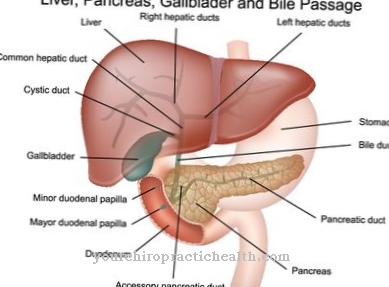At a Hypersplenism is a condition that may be associated with splenomegaly. The spleen enlarges, which increases its functional effects more than necessary and causes difficulties.
What is hypersplenism?

© ylivdesign - stock.adobe.com
Basically the term denotes Hypersplenism an overactive spleen. The synonymous name may also be used for the disease Hypersplenia used. In the majority of cases, hypersplenism develops as a result of an enlarged spleen.
This disease is known as a complication of splenomegaly. In connection with the enlargement of the organ, its capacity is significantly increased. This causes a greater number of blood cells to accumulate inside the spleen.
In addition, more blood cells are released from the organ. As a result, the blood cells decrease, which is also known as pancytopenia. The different types of blood cells such as leukocytes, erythrocytes and platelets are involved to different degrees. The organism tries to compensate for the pathological condition by increasing the bone marrow.
causes
There are several causes for the development of hypersplenism. As a rule, certain underlying diseases are responsible for the formation of hypersplenism. Very often these are blood-related diseases, rheumatoid arthritis or high pressure in the portal veins.
Basically, a distinction is made between primary and secondary hypersplenism. A primary hypersplenism is, for example, in connection with the so-called Banti disease. Secondary hypersplenism is possible in several diseases that involve enlargement of the spleen.
In addition, various infections are possible causes, such as malaria, kala-azar or Felty syndrome. In addition, some malignant lymphomas, cirrhosis of the liver or various autoimmune diseases such as erythematosus lead to the formation of hypersplenism. In addition, various storage diseases, such as Gaucher syndrome or thesaurismoses, are able to trigger hypersplenism.
In principle, there is no other underlying disease in primary hypersplenism. Secondary causes are, for example, diseases of the bile or liver such as viral hepatitis or cholangitis. Hematogenic causes exist, for example, in hemolytic anemia, leukemia or Hodgkin's disease.
Possible storage diseases are hemochromatosis or glycogenosis. Infectious diseases that may cause hypersplenism are AIDS, typhoid, mononucleosis and leptospirosis. Toxoplasmosis, Bang's disease, rubella and paratyphoid are also among them.
Symptoms, ailments & signs
Hypersplenism is associated with a number of typical symptoms and complaints. The enlargement of the spleen causes more blood cells to be released from the organ. These are primarily erythrocytes, leukocytes and platelets.
Pancytopenia, a so-called cell poverty, develops as a result. The different types of blood cells are involved to different degrees. Frequent blood transfusions may be necessary if anemia develops. Thrombocytopenia increases the tendency to bleed, while leukocytopenia makes the affected patient more susceptible to infectious diseases.
As a reaction to the enlargement of the spleen, hypertrophy of the bone marrow, which is responsible for blood formation, occurs. If the spleen is particularly enlarged, it may lead to pain as neighboring organs are squeezed. General symptoms of hypersplenism show up, for example, in dry mucous membranes, signs of anemia or an unusually strong craving for sweet foods.
With a slight enlargement of the spleen, symptoms of endocarditis or typhoid are possible. A medium magnification manifests itself, for example, in leukemia, hepatitis or liver cirrhosis. If the spleen is particularly enlarged, the affected patients sometimes suffer from a feeling of pressure in the upper abdominal area on the left side of the body.
In principle, the functions of the spleen increase according to the degree of its enlargement. The consequences are cytopenia, anemia, or thrombocytopenia. Hyperplasia of the bone marrow is also possible.
Diagnosis & course of disease
If a person has one or more typical symptoms of hypersplenism, seek medical advice. In the first step of the examination, the attending physician analyzes the patient's medical history. Following the anamnesis, various clinical examinations are carried out. For example, the spleen is felt, which is significantly enlarged in hypersplenism.
An ultrasound examination clearly shows the enlargement of the spleen and indicates the disease. A blood test will confirm suspicion of a diagnosis of hypersplenism. This shows the reduced proportion of blood cells. The increased bone marrow can also be seen through laboratory tests. A reliable diagnosis can be made using scintigraphy.
Complications
In most cases, hypersplenism leads to enlargement of the spleen. There is severe pain for the patient. If the hypersplenism is not treated, various complaints can arise over time. As a rule, the patient is more susceptible to infections and inflammation and as a result becomes sick more often. The person concerned feels weak and exhausted and no longer takes an active part in life.
The enlargement of the spleen can also displace or squeeze other organs, which leads to complications in the affected organs. In the further course it comes to liver cirrhosis and in the worst case also to leukemia. The person affected also suffers from uncomfortable feelings of pressure on the left side of the body, which complicates everyday life for the person concerned and severely limits the quality of life. Without treatment, in the worst case scenario, the patient can die.
In many cases, with hypersplenism, the spleen is completely removed from the patient's body. Since this organ is not essential to life, there are no further complications. In many cases, however, the symptoms can be limited with the help of blood transfusions, so that no surgical intervention is necessary.
When should you go to the doctor?
A doctor should be consulted if the face is noticeably pale, or if there is internal weakness or exhaustion. If heavy bleeding occurs with minor injuries, this is considered unusual and must be checked. The affected person is threatened with an undersupply of the organism and thus a life-threatening condition due to the existing anemia. Dizziness, unsteady gait, weakness and loss of energy are indications that should be investigated. If the person concerned suffers from infections more often or is susceptible to inflammation, a control visit is advisable to clarify the information.
Pain, difficulty breathing or tightness in the upper body should be examined and treated. Dry mouth, dry mucous membranes or difficulty swallowing should also be medically clarified. If the person concerned has the need to consume more sweet food, this is considered unusual. A doctor should be consulted if this urge for sweet foods persists for several weeks or months.
If you experience headaches, increased palpitations or decreased mental performance, a doctor's visit is advisable. A doctor is required in the event of decreased physical strength or increased fatigue. Loss of drive, withdrawal behavior and a melancholy mood are indications that should be followed up. If there are disturbances in attention or unsteady gait, a doctor's visit is advisable.
Doctors & therapists in your area
Treatment & Therapy
There are various options for treating hypersplenism. On the one hand, regular blood transfusions are an option to compensate for the lack of blood cells. This is especially the case with anemia or thrombocytopenia.
In principle, however, the spleen is not an essential organ for the viability of the human organism. For this reason, the removal of the spleen (medical term splenectomy) is recommended for serious complaints.
Outlook & forecast
The overactive spleen can have various causes. These are decisive for the prognosis of hypersplenism. If the complication occurs as a result of cancer, the prognosis is based on the prospect of a cure, the time of diagnosis, the general health of the patient and the effectiveness of the therapy. If the cancer therapy is successful and all follow-up treatments are completed, the hypersplenism can completely regress.
If the cancer has progressed so far that a cure can no longer be achieved, the treatment plan is restructured. The goal then is to alleviate the symptoms of serious impairments and not to cure hypersplenism.
In the case of a chronic underlying disease, regression of the enlarged organ is not indicated. In long-term therapy, the organism is regularly supported with the necessary blood cells. Permanent regeneration of the spleen is rarely or not at all achieved. If the treatment plan calls for removal of the spleen, all symptoms associated with hypersplenism will heal spontaneously.
The non-vital organ can be removed from the patient in a routine procedure in the event of severe pain or if there is no prospect of symptom relief in an operation. Since a surgical procedure is generally associated with risks and side effects, there can be sequelae or complications.
prevention
Concrete methods and measures for the effective prevention of hypersplenism are currently not known or not sufficiently researched. It is all the more relevant to consult a suitable doctor at the first signs of hypersplenism and have the symptoms examined. Because an early diagnosis has a positive effect on the prognosis.
Aftercare
Follow-up treatment for hypersplenism depends on the severity of the disease and on whether the spleen was removed in an operation. In general, the disease cannot be prevented by taking your own precautionary measures. Medical therapy is therefore essential for the patient.
During follow-up care, it is important to recognize early signs of a relapse immediately and to examine them during a medical appointment. The sooner the diagnosis is made, the better the prognosis for those affected. Patients should also take it easy in the follow-up phase. Physically strenuous activities and stress are extremely stressful and can have a negative impact on health.
Generally, patients receive regular blood transfusions. A consistent appointment is very important here. In connection with anemia in particular, doctors recommend close monitoring in order to identify any deficiency symptoms or other complaints in good time. There are special dietary supplements to combat the typical deficiency symptoms in patients.
The attending physician can estimate which products are suitable for the individual case and how high they should be dosed. That is why the use of such agents should be carried out in close consultation with the doctor.
You can do that yourself
Hypersplenism cannot usually be treated by means of self-help. Those affected are in any case dependent on medical treatment so that there is no reduced life expectancy.
With this disease, it is important for patients to take care of themselves and not expose themselves to strenuous activities or unnecessary stress. Since symptoms can only be treated with regular blood transfusions, care should be taken to ensure that they are performed regularly. Regular examinations are necessary, especially if you have anemia. Since some sufferers also suffer from deficiency symptoms, dietary supplements can be taken here. However, the type and amount of these agents should always be discussed with a doctor first.
In severe cases, those affected by hypersplenism have to rely on the removal of the spleen. In order to avoid complications with this disease, a doctor should be consulted at the first signs. Often the contact and exchange of information with other sick people also has a very positive effect on the course of the disease. Talking to family members or friends is very helpful if you have psychological problems. In serious cases, a psychologist can also provide help.



.jpg)
.jpg)
.jpg)


















.jpg)



